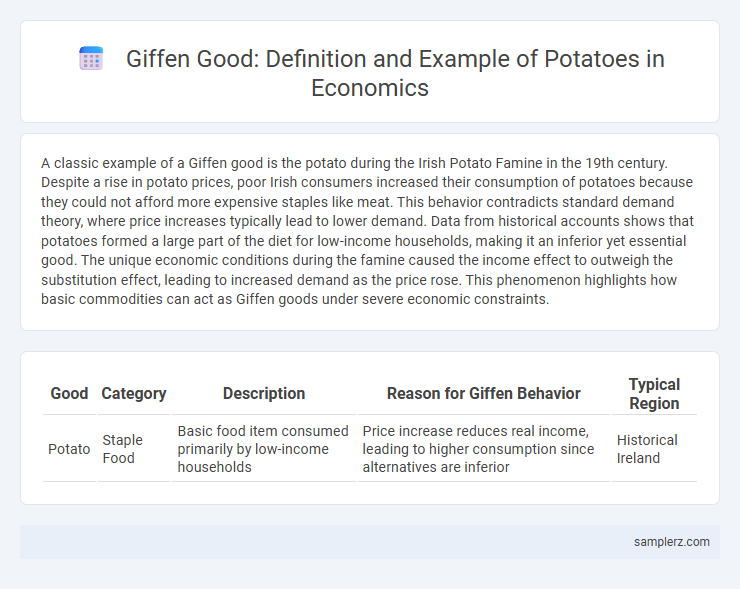A classic example of a Giffen good is the potato during the Irish Potato Famine in the 19th century. Despite a rise in potato prices, poor Irish consumers increased their consumption of potatoes because they could not afford more expensive staples like meat. This behavior contradicts standard demand theory, where price increases typically lead to lower demand. Data from historical accounts shows that potatoes formed a large part of the diet for low-income households, making it an inferior yet essential good. The unique economic conditions during the famine caused the income effect to outweigh the substitution effect, leading to increased demand as the price rose. This phenomenon highlights how basic commodities can act as Giffen goods under severe economic constraints.
Table of Comparison
| Good | Category | Description | Reason for Giffen Behavior | Typical Region |
|---|---|---|---|---|
| Potato | Staple Food | Basic food item consumed primarily by low-income households | Price increase reduces real income, leading to higher consumption since alternatives are inferior | Historical Ireland |
Understanding Giffen Goods: The Case of Potatoes
Potatoes serve as a classic example of Giffen goods, where a price increase leads to higher demand due to their status as an essential staple for low-income consumers. When potato prices rise, these consumers reduce purchases of more expensive alternatives and buy more potatoes despite the higher price. This counterintuitive demand behavior highlights how income and substitution effects interact in Giffen goods.
Historical Overview: Potatoes as a Giffen Good
During the Irish Potato Famine in the mid-19th century, potatoes exhibited characteristics of a Giffen good, where rising prices led impoverished consumers to buy more due to limited alternatives. Economic studies highlight how staple food shortages forced low-income households to allocate a larger budget share to potatoes, despite price increases. This historical case remains a key example in behavioral economics demonstrating non-standard demand responses in essential commodities.
Economic Theory Behind Giffen Goods and Potatoes
Giffen goods, such as potatoes during the Irish Potato Famine, demonstrate a counterintuitive economic theory where demand rises as prices increase due to strong income effects overpowering substitution effects. This phenomenon occurs when potatoes constitute a staple, inferior good for low-income consumers, making them consume more as prices rise because they cannot afford more expensive alternatives. The economic theory highlights how basic necessities with limited substitutes can defy traditional demand laws under severe budget constraints.
The Irish Potato Famine: A Classic Giffen Good Example
During the Irish Potato Famine of the mid-19th century, potatoes became a classic example of a Giffen good as their price increase led to higher consumption among impoverished populations. As potatoes were a staple food with limited affordable substitutes, rising prices forced families to allocate more of their constrained budgets toward this essential calorie source. This counterintuitive demand behavior illustrated core Giffen good characteristics, where income effects outweighed substitution effects in economic theory.
Price Changes and Potato Consumption Patterns
Potato consumption patterns during price changes highlight the unique behavior of Giffen goods, where an increase in potato prices leads to higher demand among low-income consumers. This counterintuitive effect occurs because potatoes serve as a staple food, and as prices rise, consumers reduce spending on more expensive alternatives, increasing reliance on potatoes. Empirical studies in regions such as rural China demonstrate that when potato prices surge, households allocate a larger portion of their budget to potatoes, reinforcing its status as a classic Giffen good.
Income Effect and Substitution Effect in Giffen Potatoes
Giffen potatoes exemplify a rare economic phenomenon where the income effect outweighs the substitution effect, causing demand to rise as prices increase. When potato prices rise, low-income consumers experience a decrease in real income, leading them to buy more potatoes because they can no longer afford more expensive substitutes. This contrasts with typical goods, where higher prices result in lower demand due to substitution toward cheaper alternatives.
Real-World Studies on Potatoes as Giffen Goods
Real-world studies on potatoes as Giffen goods reveal that in specific regions, such as rural China, rising potato prices led to increased consumption despite higher costs, contradicting typical demand laws. These studies highlight how low-income households rely heavily on potatoes as a staple, causing quantity demanded to rise when prices increase due to income effects outweighing substitution effects. Experimental data from Anhui province demonstrates this unique consumer behavior, confirming the rare existence of Giffen goods in practical economic contexts.
Modern Examples: Are Potatoes Still Giffen Goods Today?
Potatoes have long been cited as a classic example of Giffen goods, especially during periods of economic hardship such as the Irish Potato Famine when their demand increased despite rising prices. Recent empirical studies in certain impoverished regions continue to observe Giffen behavior with potatoes, where staple food scarcity and limited substitutes cause consumers to buy more as prices rise. Modern examples suggest that potatoes retain Giffen good characteristics primarily in low-income markets facing severe budget constraints and food insecurity.
Policy Implications of Giffen Behavior in Staple Foods
The phenomenon of Giffen behavior in staple foods like potatoes highlights crucial policy implications, as price increases can paradoxically lead to higher consumption due to their role as essential calories for low-income households. Policymakers must consider that subsidies or price controls aimed at reducing staple food prices might unintentionally decrease demand, complicating efforts to improve food security. Understanding Giffen goods helps design targeted interventions that stabilize consumption patterns while addressing nutritional needs and poverty alleviation.
Lessons Learned from Potato Giffen Good Phenomena
The potato Giffen good phenomenon demonstrates how rising prices can increase demand due to the strong income effect outweighing the substitution effect in low-income households. This anomaly highlights the importance of understanding consumer behavior in staple food markets during economic hardship. Policymakers must consider these dynamics to design effective food assistance programs that prevent nutritional deficits in vulnerable populations.

example of Giffen good in potato Infographic
 samplerz.com
samplerz.com